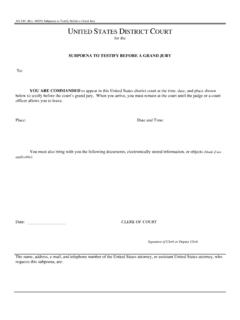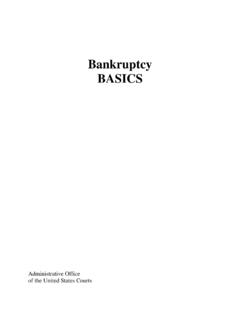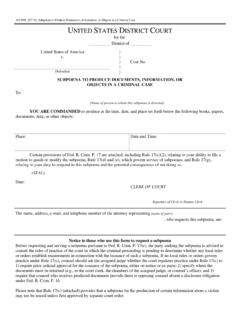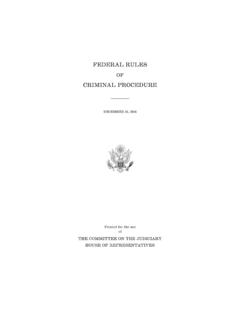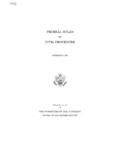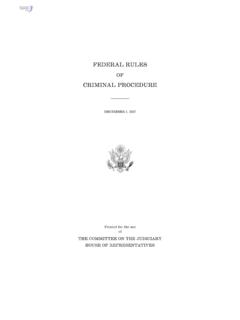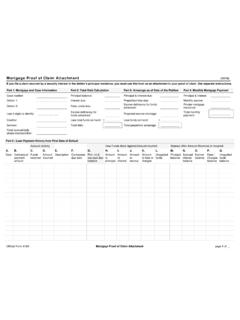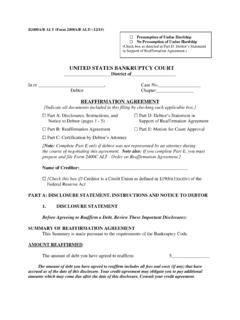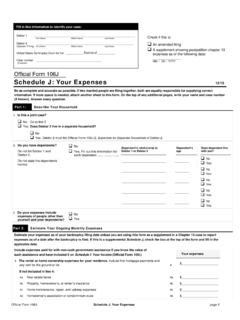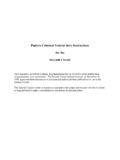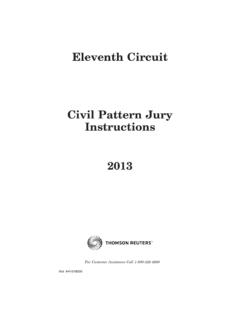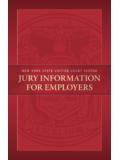Transcription of HANDBOOK FOR TRIAL JURORS SERVING IN THE …
1 HANDBOOK FOR TRIALJURORSSERVING IN THEUNITED STATES DISTRICT COURTSP repared for the use of TRIAL JURORS SERVING in the United States district courts under the supervision of the Judicial Conference of the United States. Published by the Administrative Office of the United States Courts, Washington, 20544. OF THIS HANDBOOK ..1 IMPORTANCE OF JURY SERVICE ..1 THE COURTS ..2 THE CRIMINAL CASE ..3 THE CIVIL CASE ..4 THE VOIR DIRE EXAMINATION ..4 THE JURORS SOLEMN OATH ..6 THE EIGHT STAGES OF TRIAL ..6 THE ARGUMENTS OF COUNSEL ..8 THE CHARGE TO THE JURY S VERDICT ..9 COURTROOM ETIQUETTE ..9 CONDUCT OF THE JURY DURING THE TRIAL ..10IN THE JURY ROOM ..13 AFTER THE TRIAL ..14 CONCLUSION ..14 PURPOSE OF THIS HANDBOOK The purpose of this HANDBOOK is to acquaint TRIAL JURORS with the general nature and importance of their role as JURORS .
2 It explains some of the language and procedures used in court, and it offers some suggestions helpful to JURORS in performing this important public service. Nothing in this HANDBOOK is to be regarded by JURORS as instructions of law to be applied by them in any case in which they serve. The judge will instruct the jury in each separate case as to the law of that case. For example, in each criminal case, the judge will tell the jury, among other things, that a defendant charged with a crime is presumed to be innocent and the burden of proving his guilt beyond a reasonable doubt is upon the Government. JURORS must follow only the instructions of law given to them by the TRIAL judge in each particular OF JURY SERVICE JURORS perform a vital role in the American system of justice. The protection of our rights and liberties is largely achieved through the teamwork of judge and jury who, working together in a common effort, put into practice the principles of our great heritage of freedom.
3 The judge determines the law to be applied in the case while the jury decides the facts. Thus, in a very important way, JURORS become a part of the court itself. JURORS must be men and women of sound judgment, absolute honesty, and a complete sense of fairness. Jury service is a high duty of citizenship. JURORS aid in the maintenance of law and order and uphold justice among their fellow citizens. Their greatest reward is the knowledge that they have discharged this 1duty faithfully, honorably, and well. In addition to determining and adjusting property rights, JURORS may also be asked to decide questions involving a crime for which a person may be fined, placed on probation, or confined in prison. In a very real sense, therefore, the people must rely on JURORS for the protection of life, liberty, and the pursuit of COURTS In this country, there are two systems of courts.
4 They are the courts of the individual 50 states and the District of Columbia and the courts of the Federal Government. This book is written for JURORS selected to serve in the TRIAL court of the Federal Government, the United States District Court. The types of cases that can be brought in this court have been fixed by the United States Congress according to our Federal Constitution. Cases in the United States District Courts are divided into two general classes. These are called criminal cases and civil cases. Criminal cases are those in which individuals or organizations are charged with breaking the criminal laws. Typical criminal charges in a federal court are those involving violation of the federal income tax and narcotics laws, mail theft, and counterfeiting. Civil cases are suits in which persons who disagree over their rights and duties come into court to settle the matter.
5 A typical example of a civil case is one involving a broken contract. One party may claim that it should be paid under the terms of the contract, while the other side may assert a defense to the claim, such as the lack of a binding contract. The court is asked to decide who is right. This depends on the law as laid down by the judge and the facts as decided by the CRIMINAL CASE The person charged with a violation of the law is the defendant. The charge against the defendant may be brought in two ways. One way is by means of an indictment; the other is by an information. An indictment is a written accusation by a grand jury that charges the defendant with committing an offense against the law. Each offense charged will usually be set forth in a separate count of the indictment. An information is the name given to a written charge against the defendant filed by the United States Attorney and not by the grand jury.
6 But even in cases where the defendant has the right to have a grand jury consider the charges presented, the defendant may agree to give up this right and consent to the filing of an information. After the indictment or information is filed, the defendant appears in open court where the court advises the defendant of the charge and asks whether the defendant pleads guilty or not guilty. This procedure is called the arraignment. No TRIAL is needed if the defendant pleads guilty and admits to committing the crime. But if the defendant pleads not guilty, he or she will then be placed on TRIAL . The judge in a criminal case tells the jury what the law is. The jury must determine what the true facts are. On that basis, the jury has only to determine whether the defendant is guilty or not guilty of each offense charged.
7 The subsequent sentencing is the sole responsibility of the judge. In other words, in arriving at an impartial verdict as to guilt or innocence of a jury defendant, the jury is not to consider a The jury must consider separately each of the charges against the defendant, after which it may find the person: not guilty of any of the charges, guilty of all the charges, or guilty of some of the charges and not guilty of CIVIL CASE The following is an example of the kind of civil case JURORS in a United States District Court will help decide. Let us call the case John Smith v. XY Company. This means that John Smith has filed a case against the XY Company. John Smith is called the plaintiff, the person who begins the case. The XY Company is the defendant. The plaintiff and the defendant are the parties.
8 The plaintiff, John Smith, states his claim in a paper called the complaint. The defendant, XY Company, replies to the complaint in a paper called the answer. The complaint and the answer are the main pleadings in the case. The points in the pleadings about which the parties disagree make up the issues of fact and law. Sometimes these issues are set forth in a pretrial order. This is an order drawn up by the judge after consulting with the attorneys for the VOIR DIRE EXAMINATION To begin a jury TRIAL , a panel of prospective JURORS is called into the courtroom. This panel will include a number of persons from whom a jury will be selected to try the case. In criminal trials, alternate JURORS may be chosen to take the place of JURORS who become ill during the TRIAL . The panel members are sworn to answer questions about their qualifications to sit as JURORS in the case.
9 This questioning 4process is called the voir dire. This is an examination conducted by the judge and sometimes includes participation by counsel. A deliberately untruthful answer to any fair question could result in serious punishment to the person making it. The voir dire examination opens with a short statement about the case. The purpose is to inform the JURORS what the case is about and to identify the parties and their lawyers. Questions are then asked to find out whether any individuals on the panel have any personal interest in the case or know of any reason why they cannot render an impartial verdict. The court also wants to know whether any member of the panel is related to or personally acquainted with the parties, their lawyers, or the witnesses who will appear during TRIAL .
10 Other questions will determine whether any panel members have a prejudice or a feeling that might influence them in rendering a verdict. Any juror having knowledge of the case should explain this to the judge. Parties on either side may ask that a member of the panel be excused or exempted from service on a particular jury. These requests, or demands, are called challenges. A person may be challenged for cause if the examination shows he or she might be prejudiced. The judge will excuse an individual from the panel if the cause raised in the challenge is sufficient. There is no limit to the number of challenges for cause, which either party may make. The parties also have a right to a certain number of challenges for which no cause is necessary. These are called peremptory challenges.
